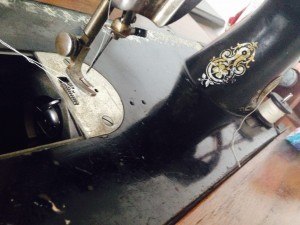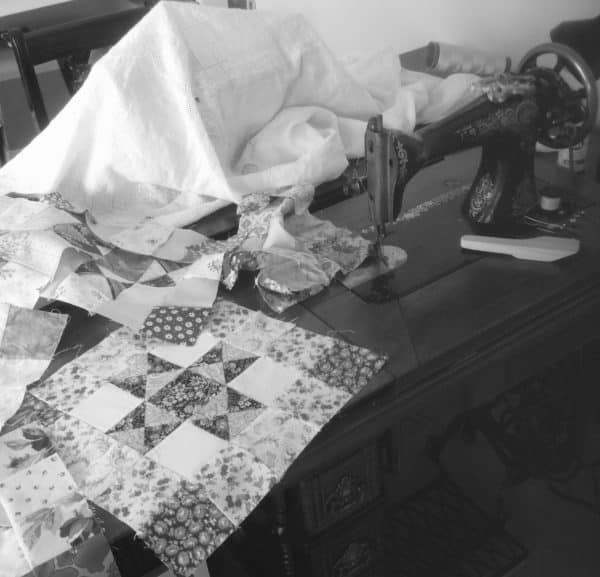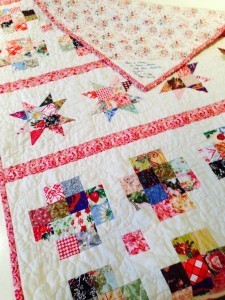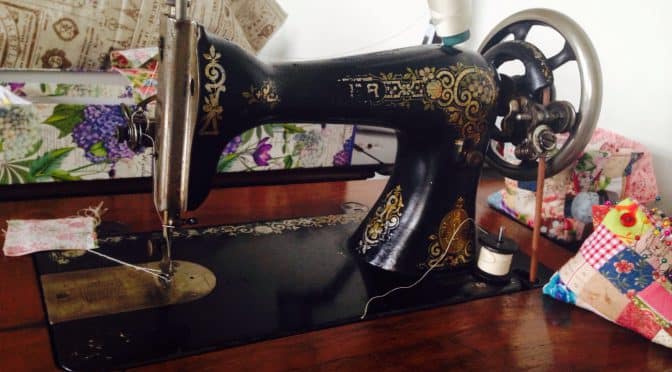Treadle Tinkering
Hello Dear Friends and Readers. Treadle sewing machines are just beautiful.
Some years ago now, my dear husband bought me a treadle machine for my birthday. Of course it came from our favourite store “Mackay’s Mart” on Unley Road. I just loved the look of it. As I have previously described, I think they make the most beautiful occasional tables, even if you are not a sewer.
So it came home and I polished it up the timber exterior a bit, and it sat in the tiny nook of our front hall for a few years, with the top down.

One day, feeling a burst of inspiration (actually this occurred after I had proudly brought another vintage machine to full working order – but that’s another story) I decided to open the lid on the old treadle and see what sort of state it was in. Of course the belt was broken, and a lot of the outside was seized up with rust and dust. So then I wondered “Could I actually get this one to work?”
My mother always says “if you don’t know where to start, start at the beginning” …. Where is that by the way? Cleaning? Seemed a logical place to start. After consulting with Dr Google and drawing from my previous experiences of restorations, I decided to start the cleaning project using lint free cloths and sewing machine oil. With old machines and their lovely surfaces and decals, the last thing you want to do is completely ruin them with harsh modern cleaning products.
This old treadle, is a Singer Class 15 from 1902. If you are lucky enough to have an old Singer, you can date them and find out which machine you have from the http://ismacs.net data base. This is a wonderful resource.
I think it’s not unreasonable to say, that with a machine which is well over 100 years old, and possibly has not been used for the last 20 to 50 years, it’s not going to clean up in one sitting. The thick layers of dust and rust take their toll. I literally gave it a fair soaking in sewing machine oil and rubbed off what was possible. Thereafter I left a rag soaked in the oil on the metal needle plate part of the machine and around the presser foot, as I could not open the sliding needle plate to expose the bobbin. I left it for some days then came back and repeated, cleaned off what was possible, and repeated this process several times within a couple of months. I was now able to open the metal slider of the needle plate to expose the bobbin. The bobbin case was intact with bobbin inside which I was also delighted to find. Its a vertical bobbin and bobbin case and easy enough to insert and remove. I took it out and as expected, found a considerable amount of old thread in the bobbin and bobbin holding mechanism. It may seem obvious, but this is often the first place to start of any machine which is not running well. A lot of old jammed up thread doesn’t help.
Using tweezers and a lot of patience I removed a large amount of lint and thread from the mechanism.

The next thing was to get hold of a new sewing machine belt which I thought may be very difficult, but in the end I got one from the All Make Sewing Centre on Goodwood Road. Fitting the belt was a little more difficult. The belt shouldn’t be too tight. My husband drilled small holes in the ends of the leather to refit the staple. Hammering through with a nail didn’t work. It split the leather. I have since discovered that there is a special tool made for this job. They are called belt pliers.
The remaining challenges were winding the bobbin which turned out to be easy and correct threading. The needle is threaded from left to right on this machine.

I love using the treadle. It took a while to get the hang of it. The balance wheel must be turned forward in order to make the machine stitch. If it rolls backwards, the thread will snap. It does not sew backwards.

The Treadle pedals are connected to to lovely timber Pitman rod which drives the wheel which is attached to the balance wheel at the top. I know that the Singer 201 was considered the ” Rolls Royce” of sewing machines but…..there is someting absolutely extraordinary about this Singer 15 Treadle. This machine is exceptional. When you consider it was made in 1902, the stitch is and the ease of use extraordinary, and its exceptionally artistically ahead of its time. Even winding the bobbin is a joy and it lasts so long I’ve almost forgotton how to rethread the machine. If you get a chance to own one of these….. Don’t hesitate….
It is lovely to rescue an old sewing machine and table which I thought may only be for its aesthetic appeal and then restore to a fully working machine.
I’m no expert on machines, but I can say that Singer made hundreds of thousands of machines, so it is possible to find replacement parts. It could be very difficult with some more obscure brands.
The experts will take them apart completely but with a bit of patience and machine oil, sometimes an amateur can fix them too, if they are not too far gone!
This machine sews really beautiful straight stitch, and very tiny stitching too if desired. As quilting patchwork is mostly straight sewing it’s ideal.

For example this baby quilt, Stars and Crosses Band Quilt was all pieced on this treadle.
Here is a link to the pattern…
If you enjoyed this post you may also like
Happy sewing!


Thanks for this. Brought back lots of memories. I learned to sew on a treadle when I was about 5 thanks to my Nanna. I’d love to have one but haven’t got the space now sadly.
I have Minnesota treadle machine in a lovely cabinet. The movers jammed the lid and I cannot get it open. Any suggestions?
My first treadle was a Singer 127 that used shuttles,I found them to be such a pain. I came across an electric Singer model15 in a lovely cabinet and home it came with full intention of making a treadle out of it. I was on the vintage singer, sewing machine page on Facebook and mentioned what I wanted to do. The guys in the group found quite humorous and told me that it couldn’t be done. Well that just made me more determined so I’m getting the light and what came in the motor and the 127 came out of the treadle cabinet. I snagged the hand wheel off the 127 and put it on the 15. Hooked up the belt and listened to the hum of the treadle. Then I took a video of me, sewing with the 15 and posted it on the group and asked the naysayers what they thought of the video. They were pretty humble after that.
Good for you Patti. It is nice to get the machine you want!
Susie love your site!!
I have a singer treadle machine but mine is not as old in that it comes in a cabinet not a table is of the range where they started combining the treadle with electricity. I have not tried it yet, been a bit nervous, but I would love to use it. I have heard that the older machines are best for any bulky sewing like the rope baskets, floor rugs, leather and some mixed media artwork. I have not tried it yet. I have a few of the machines from different companies that I have been given when people wanted to get rid of them.
I inherited a 1937 singer that had been motorized. It belonged to my mother in law who bought it new in 1938 and it was well loved and used thru the years. It is my favorite for any sewing projects especially quilts.
Don’t be afraid to use it. They are solid metal and not made to be babied. Very easy to clean and oil. Simple design with few adjustments.
I have the same machine, I love it. Your blog is very nice, I am enjoying the posts, thanks so much.
Thank you. I really love this machine for quilt piecing. I think it’s my favourite for piecing. It has such a big bobbin and it feels easy to use. And treadling is so theraputic!
Me too! Mine came with an insert top, and a drip tray underneath but no table flap, and wooden round top cover. I’ve never seen another machine with these lovely “ginger bread” decals, which glow with colour, and mine has no singer badge pinned on, rather the badge is part of the decal. I think mine’s 1903 and possibly made in a German factory. I’m planning to mount it on an industrial width cast iron treadle, which I’ve bought. This is about 4” wider than the domestic version, and so the needle position with be further right, nearer the centre. I want to sit with the needle central! (This is because industrial machines were also wider). I will also raise the table top height a bit, because I’ve got long legs. Longer than the average man a century ago, let alone woman. Come to think of it, I’m taller than the average man today!